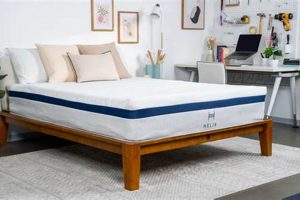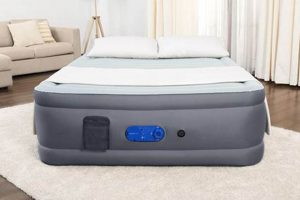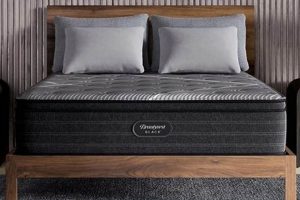A mattress offering a balance between firm support and plush comfort is often described as a mid-range option. These mattresses are designed to accommodate a variety of sleeping positions and body types, providing adequate spinal alignment while minimizing pressure points. For example, an individual seeking relief from back pain may find this type of mattress suitable due to its ability to conform to the body without excessive sinking.
The popularity of this mattress category stems from its versatility and potential to enhance sleep quality. A mattress that is neither too firm nor too soft can promote proper spinal alignment, reduce tossing and turning, and contribute to a more restful night’s sleep. Historically, mattress design has evolved to meet diverse consumer needs, with the development of materials and construction techniques that allow for customized levels of support and comfort. The adaptability of this mattress option renders it appropriate for couples with differing sleep preferences and individuals who change positions throughout the night.
The following sections will delve into the key factors to consider when evaluating mattresses in this category, including material composition, construction methods, and suitability for specific sleep needs. Further exploration will cover the impact of these mattresses on overall sleep health and provide guidance on selecting the appropriate product for individual requirements.
Guidance for Mattress Selection
Selecting a mattress requires careful consideration of individual needs and preferences. This section provides guidance to assist in making an informed decision.
Tip 1: Evaluate Material Composition: Mattress materials significantly affect comfort and durability. Memory foam conforms to the body, providing pressure relief, while innerspring systems offer support and breathability. Hybrid models combine these materials for a balanced feel. Assess material certifications, such as CertiPUR-US, to ensure the absence of harmful chemicals.
Tip 2: Consider Construction Quality: Mattress construction impacts longevity and support. Reinforced edges prevent sagging, while quilted covers enhance comfort. Examine stitching and overall craftsmanship to gauge the mattress’s durability.
Tip 3: Assess Sleep Position Compatibility: Side sleepers often benefit from a mattress with enhanced pressure relief in the shoulder and hip areas. Back sleepers require ample lumbar support. Stomach sleepers should prioritize a firmer surface to prevent spinal misalignment. Understanding individual sleep habits is essential for selecting an appropriate mattress.
Tip 4: Investigate Trial Periods and Warranties: Many mattress companies offer trial periods, allowing customers to test the mattress in their own homes. Warranties protect against manufacturing defects and premature sagging. Review the terms and conditions of both before making a purchase.
Tip 5: Research Brand Reputation: Established brands often have a track record of quality and customer satisfaction. Consult reviews and ratings from independent sources to gain insights into the experiences of other consumers.
Tip 6: Determine Budgetary Constraints: Mattress prices vary widely. Establish a budget before beginning the selection process and compare mattresses within that range. Factor in potential additional costs, such as shipping or disposal fees.
These considerations can significantly enhance the likelihood of choosing a mattress that aligns with individual needs and preferences, promoting improved sleep quality and overall well-being.
The concluding section will summarize the key factors discussed and offer final recommendations for selecting the optimal mattress.
1. Balanced Support
Balanced support is a defining characteristic of a mattress in this category. It refers to the mattress’s ability to provide both adequate support and a degree of comfort that allows the sleeper to rest without experiencing undue pressure points or spinal misalignment. The proper equilibrium between support and comfort is crucial for promoting restful sleep and preventing associated physical discomfort.
A mattress that provides balanced support is designed to conform to the sleeper’s body while also maintaining proper spinal alignment. The degree of conformance ensures pressure relief, especially in areas such as the shoulders, hips, and knees. Simultaneously, the support prevents excessive sinking, which can lead to spinal curvature and lower back pain. Consider, for example, an individual who sleeps on their side. A mattress lacking balanced support might cause their shoulder to sink too deeply, leading to shoulder pain and reduced circulation. Conversely, insufficient conformance could result in pressure points along the spine, disrupting sleep and causing discomfort.
In summary, balanced support represents a foundational element of an effective mattress in this category. It addresses both comfort and spinal health. Achieving this balance demands a thoughtful combination of materials and construction techniques. The ultimate outcome is improved sleep quality and long-term physical well-being.
2. Pressure Relief
Pressure relief is a critical factor in mattress design and selection. A mattress offering appropriate pressure relief minimizes concentrated stress on areas of the body that bear the most weight during sleep, such as the hips, shoulders, and back. This is particularly relevant for individuals who sleep on their side or back, as these positions can exacerbate pressure points. Insufficient pressure relief can lead to discomfort, tossing and turning, and disrupted sleep patterns. A mattress constructed with materials that contour to the body’s shape is essential for achieving effective pressure relief. A practical example is a mattress incorporating a memory foam layer, which responds to body heat and weight to distribute pressure more evenly.
Achieving effective pressure relief through mattress design involves a careful selection of materials and construction techniques. The density and thickness of comfort layers, such as memory foam or latex, directly influence the degree of pressure relief provided. Mattresses with strategically zoned support can also target specific areas of the body to alleviate pressure where it is needed most. For instance, a zoned mattress might feature softer foam in the shoulder area and firmer support in the lumbar region. This approach can be particularly beneficial for individuals with back pain or other musculoskeletal issues.
In summary, pressure relief is a fundamental component of mattress design that significantly impacts sleep quality and overall comfort. Mattresses engineered to minimize pressure points can contribute to a more restful night’s sleep and reduce the likelihood of pain and discomfort. Therefore, it is important to consider the pressure-relieving properties of a mattress when m
aking a selection. Mattresses offering pressure relief are more likely to have long term support for the body of those who choose those mattresses.
3. Spinal Alignment
Proper spinal alignment during sleep is crucial for musculoskeletal health and overall well-being. The degree to which a mattress supports natural spinal curvature directly affects sleep quality and potential for pain or discomfort. Selection of an appropriate mattress necessitates careful consideration of its impact on spinal alignment.
- Contour and Support Balance
A mattress should conform to the body’s contours while providing adequate support to maintain the natural spinal curve. Excessive sinking or insufficient support can lead to spinal misalignment, resulting in back pain, neck stiffness, and other musculoskeletal issues. A mattress that adapts to individual body shapes and sleeping positions promotes optimal spinal alignment.
- Lumbar Support
The lumbar region of the spine requires specific attention. A mattress should provide sufficient support in this area to prevent excessive curvature or strain. Mattresses with enhanced lumbar support can help maintain proper spinal alignment, reducing the risk of lower back pain. Individuals with pre-existing back conditions should prioritize mattresses with this feature.
- Sleep Position Considerations
Different sleep positions demand varying levels of support for spinal alignment. Side sleepers require a mattress that allows the shoulders and hips to sink in enough to maintain a straight spinal column. Back sleepers need support that fills the natural curve of the lower back. Stomach sleepers often require a firmer surface to prevent excessive arching of the spine. Mattress selection should align with preferred sleep position to optimize spinal alignment.
- Material Influence
Mattress materials contribute significantly to spinal alignment. Memory foam conforms to the body, providing support and pressure relief. Latex offers a more resilient support. Innerspring systems provide a firmer base. Hybrid mattresses combine these materials to achieve a balance between comfort and support. The selection of materials impacts the mattress’s ability to promote proper spinal alignment.
The features of mattress contributes greatly to promoting spinal alignment. The degree to which these features are implemented directly correlates with the potential for reduced pain, improved sleep quality, and long-term musculoskeletal health. When assessing a mattress, prioritizing its capacity to facilitate and maintain correct spinal alignment is a critical consideration.
4. Material Quality
Material quality is a foundational element of any mattress, and its significance is amplified when considering mattresses designed to strike a balance between support and comfort. The composition of the materials directly influences the mattress’s durability, its ability to provide consistent support over time, and its capacity to regulate temperature effectively. Low-quality materials, such as inferior foams or poorly constructed coil systems, can lead to premature sagging, uneven support, and increased heat retention, negating the intended benefits of a mattress designed for balanced comfort. For example, a mattress advertised as a “best medium mattress” but constructed with low-density foam may initially feel comfortable but will quickly lose its shape and supportive properties, leading to discomfort and potentially exacerbating back pain.
The choice of materials also affects hypoallergenic properties and resistance to dust mites and other allergens. Higher-quality foams, such as natural latex or CertiPUR-US certified memory foam, are less likely to off-gas harmful chemicals and provide a healthier sleep environment. Similarly, mattress covers made from breathable, natural fibers, such as organic cotton or bamboo, can improve airflow and reduce the risk of overheating during sleep. These material choices contribute not only to the mattress’s longevity but also to the overall sleep experience and potential health benefits. A mattress with a high-quality, breathable cover and hypoallergenic materials is more likely to promote restful sleep and minimize allergic reactions, enhancing its value as a balanced and comfortable sleep solution.
In summary, material quality is not merely a superficial aspect of a mattress but a critical determinant of its performance, durability, and potential health benefits. Selecting a mattress with high-quality materials is an essential step in ensuring that the product provides consistent support, pressure relief, and temperature regulation over its lifespan. The investment in superior materials directly translates to improved sleep quality, enhanced comfort, and a greater return on the initial purchase.
5. Durability
Durability is a critical consideration when evaluating a mattress. The expected lifespan of a mattress directly impacts its long-term value. A mattress categorized as optimal offers a balance of comfort and support, and its durability ensures these qualities persist over time. This is particularly pertinent, as mattresses are a significant investment.
- Material Resilience
The materials comprising a mattress dictate its capacity to withstand prolonged use. High-density foams, robust coil systems, and reinforced edges contribute to enhanced durability. For instance, a mattress employing high-density memory foam is less prone to sagging or developing impressions than one utilizing low-density alternatives. Similarly, pocketed coil systems, where each coil is individually wrapped, tend to exhibit greater resilience than traditional interconnected coil designs. The composition of a mattress, therefore, directly impacts its capacity to maintain its structural integrity over an extended period.
- Construction Integrity
The method of construction influences a mattress’s ability to endure wear and tear. Reinforced seams, robust stitching, and a well-constructed foundation enhance its structural integrity. Mattresses constructed with meticulous attention to detail are less susceptible to premature deterioration. A mattress employing reinforced edge support, for example, will resist sagging along its perimeter, maximizing the usable sleep surface and prolonging its lifespan. Construction quality, therefore, complements material selection in determining overall durability.
- Sag Resistance
Sagging is a common indicator of diminished mattress durability. The ability of a mattress to resist sagging is directly linked to the quality of its internal components and construction. A mattress exhibiting minimal sagging after prolonged use is indicative of superior durability. Conversely, a mattress that develops significant sagging compromises its ability to provide adequate support and pressure relief, diminishing its overall value. Sag resistance, therefore, serves as a key metric for assessing the longevity and performance of a mattress.
- Warranty Coverage
Warranty provisions often reflect a manufacturer’s confidence in the durability of its
product. Comprehensive warranties provide recourse in the event of premature material degradation or structural failure. However, warranties should be carefully scrutinized for exclusions and limitations. A mattress with a generous warranty, covering sagging or structural defects, suggests that the manufacturer has confidence in its long-term performance. While a warranty does not guarantee durability, it provides a degree of protection against potential issues.
These factors collectively contribute to the overall durability of a mattress. A mattress offering optimal support and comfort, while exhibiting superior material resilience, construction integrity, sag resistance, and comprehensive warranty coverage, represents a sound investment. The interplay of these elements ensures that the mattress maintains its intended characteristics over its expected lifespan, delivering long-term value and consistent sleep quality.
6. Temperature Regulation
Temperature regulation is a crucial aspect of mattress design, particularly when considering mattresses aiming for a balance between support and comfort. The ability of a mattress to dissipate heat and maintain a comfortable sleeping temperature directly influences sleep quality. Mattresses lacking effective temperature regulation can lead to overheating, causing restlessness and disrupting sleep cycles. For instance, traditional memory foam, while known for its contouring properties, can trap heat due to its dense structure. Individuals who tend to sleep hot may find such mattresses uncomfortable, even if they provide adequate support and pressure relief. A mattress classified as a balanced option must, therefore, incorporate features that promote airflow and prevent heat accumulation.
Several strategies can be employed to enhance temperature regulation in mattresses. Open-cell foam structures allow for greater airflow compared to traditional closed-cell foams. Incorporating materials like gel-infused memory foam or latex can also aid in heat dissipation. Additionally, mattress covers made from breathable fabrics, such as cotton or bamboo, can improve airflow and reduce heat retention. Real-world examples include mattresses that utilize phase change materials, which absorb and release heat to maintain a stable temperature. These materials can help regulate temperature fluctuations throughout the night, promoting more restful sleep. The effectiveness of these features in maintaining a comfortable sleeping temperature is a key differentiator among mattresses.
In summary, temperature regulation is an essential component of a balanced mattress. The inclusion of materials and design features that promote airflow and dissipate heat is crucial for preventing overheating and ensuring sleep quality. Mattresses failing to address this aspect may compromise overall comfort, regardless of their support and pressure-relieving properties. Consequently, consumers should prioritize temperature regulation when evaluating mattresses for optimal sleep health. The practical significance of this understanding lies in the ability to select a mattress that not only supports the body but also maintains a comfortable sleeping environment.
Frequently Asked Questions About Mattresses
The following questions address common inquiries regarding mattresses, providing factual information to aid in informed decision-making.
Question 1: What defines a mattress? A mattress offers a balanced level of firmness between firm and soft, suitable for a broad range of sleepers.
This type of mattress aims to deliver both support and pressure relief, accommodating various sleeping positions and body types.
Question 2: What are the primary advantages of this option? This category offers versatility, potentially alleviating pressure points while maintaining adequate spinal alignment.
Its adaptability renders it appropriate for individuals who shift positions during sleep, or for couples with differing firmness preferences.
Question 3: How does material composition influence performance? The materials utilized significantly impact the mattress’s durability, breathability, and contouring capabilities.
Memory foam, latex, and innerspring systems each offer distinct characteristics that affect the overall sleeping experience.
Question 4: What factors should be considered when selecting one? Individuals should assess their sleep position, body weight, and any pre-existing medical conditions.
Additionally, examining the mattress’s construction, warranty, and trial period is crucial for making an informed decision.
Question 5: How does temperature regulation affect sleep quality? Mattresses with enhanced breathability prevent heat buildup, promoting a more comfortable sleep environment.
Materials like gel-infused foam or open-cell structures facilitate airflow, mitigating the risk of overheating during the night.
Question 6: What is the expected lifespan of a mattress? The lifespan depends on factors such as material quality, usage, and maintenance.
On average, it can be expected to last between seven to ten years, provided it is properly cared for and constructed with durable materials.
Understanding these core principles is essential for selecting a mattress that aligns with individual needs, promoting both comfort and long-term sleep health.
The subsequent section will offer a detailed comparison of specific mattresses currently available on the market, based on the discussed criteria.
Concluding Remarks on Selecting an Optimal Mattress
This exploration of the considerations in selecting an optimal mattress has highlighted several key factors. Balanced support, pressure relief, spinal alignment, material quality, durability, and temperature regulation each contribute significantly to the overall sleep experience. Careful evaluation of these elements is crucial for making an informed decision that aligns with individual needs and preferences. Ignoring these aspects may result in discomfort, disrupted sleep, and potential long-term health consequences.
The selection of an appropriate mattress represents a significant investment in personal well-being. Prospective purchasers should critically assess available options, considering both immediate comfort and long-term performance. By prioritizing informed decision-making, individuals can maximize the likelihood of achieving restful, restorative sleep and optimizing their overall health. Continual advancements in mattress technology and materials warrant ongoing research and adaptation to ensure the most suitable selection for evolving sleep needs.




![Top Value: Best Reasonably Priced Mattress [Deals] Organic & Natural Mattress Buyer’s Guide: Non-Toxic Sleep Solutions Top Value: Best Reasonably Priced Mattress [Deals] | Organic & Natural Mattress Buyer’s Guide: Non-Toxic Sleep Solutions](https://mattressworldpa.com/wp-content/uploads/2025/07/th-7714-300x200.jpg)


